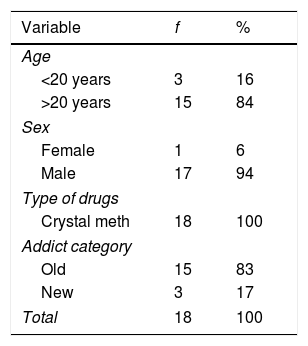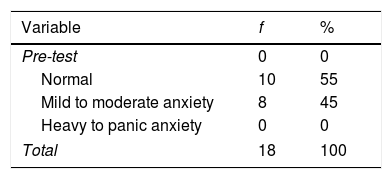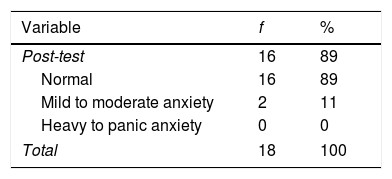Anxiety disorders are subjective feelings about mental tension as a general reaction and inability to overcome a problem or feeling insecure. SEFT (Spiritual Emotional Freedom Technique) is a combined therapy of Spiritual Power Energy, Psychology, and Spiritual. The ability to change a person's emotional state into relaxation is used as an additional intervention for NAPZA residents who are undergoing drug rehabilitation. This study aimed to determine the effect of SEFT therapy with a decrease in anxiety levels toward NAPZA residents. This research method uses a pre-experimental quantitative design. The approach used is one-group pre–post-test design. The sampling technique is consecutive sampling with a sample of 18 respondents. The results showed that there was an effect of SEFT therapy with a decrease in anxiety level toward NAPZA residents with the value of <0.001. SEFT interventions could reduce anxiety levels toward NAPZA residents. It can be used as an additional therapy for the treatment of disease without interfering with medical treatment because health workers, families, and the general public can do it. This therapy is straightforward to do cheap and practical.
Anxiety is a normal thing as a sign of a threat, a reaction to the risk of pain or the outside world that is not ready to be overcome and serves to warn individuals of danger. Uncontrolled anxiety is called traumatic. Anxiety rate in Indonesia is around 10–12% when viewed from the general population. Based on the Basic Health Research report, it showed that approximately 14.4 million or 6.4% of the population experience mental-emotional disorders as indicated by the manifestations of anxiety and depression symptoms. Anxiety is common in daily life. Based on data from the United Nations Office on Drugs and Crime,1 the estimated population of the world experienced disorders due to drug abuse (suffer from drug use disorder). As many as 29.5 million people and 190,900 people died due to drug abuse. Statistically, in Indonesia, it is estimated that the number of drug abuse cases reaches 4.1 million people or around 2.1–2.25% of the total population in 2017. The projection result of the calculation of drug abuse cases showed an increase in the number from 4.1 million in 2015 to 5.0 million in 2020.2 Men are three times more likely to abuse drugs than women, and the group of workers contributes the most extensive drug abuse.2
The preliminary study was carried out at Pelita Jiwa Insani Foundation, a Report Obligatory Recipient Institutions (IPWL) under the guidance of the Ministry of Social Affairs in the Padang City, West Sumatera. Obtained user data from January to June 2019 was as many as 118 people, with various characteristics of the average age of 17–25 years and based on the gender of 115 men and three women.
The Emotional Freedom Technique (EFT) method3 gave the changes in emotions and blood cells combined with prayer. It shows that the impact of drastic changes is both emotional and physical. EFT was further developed into Spiritual Emotional Freedom Technique (SEFT), a technique combining spirituality in the form of prayer, sincerity and submission with psychological energy in the way of a series of principles and procedures utilizing the body's energy system to improve the condition of mind, emotions and behavior through three simple techniques namely set-up, tune-up, and tapping.
MethodologyThis study compared two research groups, namely: (1) NAPZA resident groups given SEFT therapy interventions and (2) control group, NAPZA residents not given SEFT therapeutic interventions. The design of this study used a quasi-experimental design with pre–post-test design.4 Determination of NAPZA residents was based on a psychiatrist's diagnosis, and then the researcher divided the group of residents based on the treatment given. The population in this study was all NAPZA residents undergoing outpatient care in the Report Obligatory Recipient Institution (IPWL) of Pelita Jiwa Insani Foundation, Padang City. The number of samples used in this study was 18 people with an age range of 17–25 years who experienced mild anxiety to panic. Data collection was conducted from January to April 2018 using an anxiety level questionnaire with the Zung Anxiety Rating Scale (ZARS) filled out by respondents before given SEFT therapy and after given an intervention. This study used Wilcoxon match pairs test non-parametric statistical test.
ResultsBased on Table 1, most (84%) respondents aged >20 years, almost all (94%) respondents were male, all respondents (100%) used meth, and most (83%) respondents belonged to old addicts.
Based on Table 2, before being given intervention, the majority (83%) of respondents experienced mild to moderate anxiety.
Based on Table 3, after being given intervention, the level of anxiety of respondents is normal (89%).
Based on Table 4, the average anxiety level before being given intervention was 52.96 and after being given intervention was 47.04, with a standard deviation value before being given an intervention 8.717 and after being given an intervention 9.103. The maximum value before being given intervention 76 and after being given intervention was 78. In conclusion, the decrease in the average level of anxiety before and after SEFT therapy by 0.001 (p<0.05) indicates the effect of SEFT therapy with anxiety levels of NAPZA residents at Pelita Jiwa Insani Foundation of Padang.
DiscussionThe results of this study indicate a decrease in anxiety levels. Two respondents experienced an increase in anxiety due to impaired concentration of thought. These barriers were such as lack of sincerity, solemn, and confident so that they failed in the phase of set-up and tune-in. It explains that the body's meridian points would stimulate the body to release endorphin and monoamines, which are two compounds that function to control pain and encourage relaxation. Tapping helps transmit kinetic energy to the energy system and frees obstacles that cover the flow of energy.5
EFT in Indonesia was developed by Ahmad Faiz Zainnudin to become a Spiritual Emotional Freedom Technique (SEFT). SEFT is a therapeutic technique combining spiritual power and energy psychology.5–7 The difference between SEFT and EFT lies in the spiritual from the first stage to the end that has no difference. The difference is the manufacturing stage the sentence set-up 90% SEFT is EFT. Spiritual is a component that distinguishes between SEFT and EFT.5–7
SEFT therapy plays a role in reducing negative effects, stress, and increasing relaxation. Spiritual is associated with the mechanism of positive, negative, and exercise handling methods, significantly associated with better psychological well-being. Many general patients, especially NAPZA residents, seek spiritual support during illness. Religion and spirituality are both related to the use of positive (psychological) and exercise (physical) handling mechanisms.8
Religious involvement provides cognitive stimulation involved in social and recreational activities. This activity causes more efficient brain tissue,9,10 also says that the role of religion is crucial in the therapy and rehabilitation of narcotics victims. Medical therapy alone without prayer and dhikr (remembering Allah) is incomplete. Prayer and dhikr are as well as medicine. Spirituality helps one to overcome various diseases, even in different stressful situations. Positive emotions include well-being, happiness, hope, optimism, meaning and purpose, high self-esteem, and a sense of control over life. Positive energy is positive psychological energy such as being kind, merciful, or forgiving and grateful.11 Spirituality emphasizes love for others, compassion, and altruistic actions while encouraging joint meetings during social events. Prevents stress and leads to social support needed in times of trouble.
Spiritual helps encourage others to increase positive emotions. Spirituality encourages human virtue, honesty, forgiveness, gratitude, patience, increasing positive emotions, and neutralizing negative emotions.12 Spirituality or religion (including spiritual awakening), and altruism are associated with the awakening spirituality of drug addicts in attending religious activities.13
- 1.
There is a significant influence (p<0.001) of SEFT therapy with anxiety level on residents of NAPZA at Pelita Jiwa Insani Foundation of Padang.
- 2.
SEFT therapy is one of the therapeutic methods that are very useful for NAPZA residents, easily and cheaply implemented for health workers and patients’ families.
The authors declare no conflict of interest.
Peer-review under responsibility of the scientific committee of the 3rd International Conference on Healthcare and Allied Sciences (2019). Full-text and the content of it is under responsibility of authors of the article.










